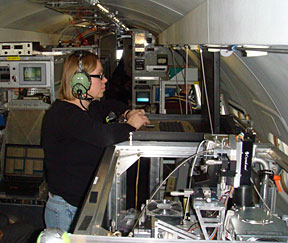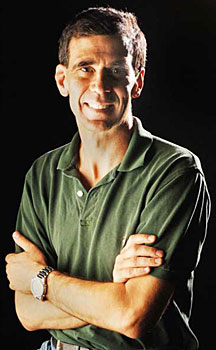Research
Highlights...
|
 |
Number 262 |
June 2, 2008 |
|
SRNL develops new form of porous glass
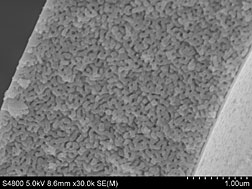 |
Image of PWHGM wall |
DOE's Savannah River National Laboratory recently developed a new geometric form of porous glass: hollow glass microspheres (HGMs), with unique porous walls— PWHGMs. The glass porosity of this material can be manipulated; it is in the range of hundreds to thousands of angstroms and has permitted the introduction of materials to the interior of the HGMs. The capability to control pore size of PWHGMs through heat treatment temperature and potentially composition can possibly meet various end-user needs—such as hydrogen storage, molecular sieves, drug and bioactive delivery systems, and environmental, as well as chemical and biological, indicators.
[Bruce Cadotte, 803/725-3879,
bruce.cadotte@srs.gov] |
|
SPLAT II samples the wind
|
PNNL’s Alla Zelenyuk used SPLAT to measure the characteristics of tiny aerosol particles in the atmosphere that contribute to climate change.
|
A one-of-a-kind instrument designed by Pacific Northwest National Laboratory researchers flew through the skies of Alaska in April to reveal how the Earth’s climate is changing. SPLAT II, a 900-pound second-generation Single Particle Laser Ablation Time-of-Flight mass spectrometer, was one of 40 specialized instruments packed into a research aircraft as part of a month-long, multi-organization Arctic field study. SPLAT is the world’s first field-deployable instrument that provides, in real time, the size, density, shape, fractal dimension, and composition of individual aerosol particles as small as 50 nanometers. The campaign was funded by DOE’s Atmospheric Radiation Measurement Program with Canadian support. A multidisciplinary PNNL team developed the instrument with DOE Basic Energy Science funding, then used DOE Atmospheric Science Program support to make SPLAT flight-ready at the Environmental Molecular Sciences Laboratory, a DOE national scientific user facility at PNNL.
[Mary Beckman, 509/375-3688,
mary.beckman@pnl.gov] |
|
Portrait of a defect
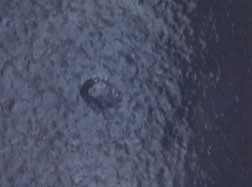 |
Photo of a suspected performance-killing defect inside an accelerator component. |
Scientists at DOE’s Jefferson Lab have snapped a clear photo of a suspected performance-killing defect inside an accelerator component. When the accelerator cavity designed for the International Linear Collider failed to perform as expected, Jefferson Lab scientists set out to find the root of the problem. Aiming a long-distance microscope inside the cavity, they found a microscopic defect. Researchers suspect that the tiny blob, about the width of a human hair, is preventing the cavity from reaching its design specifications. They hope that removing the defect will make the cavity eligible for further testing.
[Kandice Carter, 757/269-7263,
kcarter@jlab.org] |
|
Algorithm models air quality
Because of the high stakes involved in meeting air quality targets, scientists, city officials and regulators all desire an effective and accurate way not only to measure air quality but also to predict where "hot spots" of pollution are likely to occur.
To assist in that effort, Argonne environmental scientist Rao Kotamarthi and his colleagues have developed a computer algorithm that quickly and accurately assimilates observational data into a model.
"We need to forecast exactly what will happen in an air quality forecast,"
Kotamarthi said. "And the way to do that is by assimilating the data taken today into the forecast for tomorrow. But the data comes with certain types of uncertainty that most models are unable to accommodate."
While scientists have confidence in their ability to project climate scenarios out to 2020 or 2030, data assimilation methods like Kotamarthi's will help scientists create longer-term projections that will accurately assess the consequences of climate change decision-making.
[Jared Sagoff, 630/252-5549,
jsagoff@anl.gov]
|
|
Mimicking bacteria produces magnetic nanoparticles
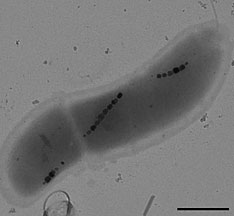 |
| Researchers used a protein cloned from magnetotactic bacteria (shown) to synthesize magnetic nanocrystals. |
A diverse, interdisciplinary group of researchers at Ames Laboratory is mimicking bacteria to synthesize magnetic nanoparticles that could be used for drug targeting and delivery, in magnetic inks and high-density memory devices, or as magnetic seals in motors. Several strains magnetotactic bacteria use a protein to form crystalline particles about 50 nanometers in size which the bacteria use like a compass needle to orient themselves with the Earth’s magnetic field. Using a protein cloned from the bacteria, researchers have been able to synthesize magnetic nanocrystals, including cobalt-ferrite crystals which are not produced naturally by bacteria.
[Kerry Gibson, 515/294-1405,
kgibson@ameslab.gov] |
|
|
Sandia’s Mark Grubelich: Fireworks fascination leads to improved
flash-bang
Imagine getting paid to indulge in your boyhood pastime of playing with explosives and blowing things up. Of course, when Mark Grubelich was a boy, the explosives were a bit less powerful than the ones he experiments with today.
Mark, a mechanical engineer and pyrotechnics expert at DOE's Sandia National Laboratories, became fascinated with rockets and fireworks as a young boy growing up in New Jersey’s Hudson River Valley (see “The Art & Science of Fireworks,” p. 6). At Sandia, he developed an improved flash-bang diversionary device, building on original groundbreaking work by retired Sandians Paul Cooper and Ed Graeber. The new flash-bang was recently licensed to Defense Technology Corporation of America.
Flash-bang devices are less-than-lethal devices used in a wide variety of law enforcement and military operations. The device is activated by pulling a pin and creates a loud sound and bright flash to temporarily distract or disorient an adversary.
Like any other explosive device, flash-bangs can be damaged in the field, poorly manufactured, or incorrectly deployed.
“There are a number of disadvantages associated with currently available diversionary devices,” says Grubelich. “Serious injuries have resulted from their improper use both operationally and in training.”
Because safety is of paramount importance, the new fuel air technology was developed to address the issues associated with the severe over-pressure that is produced in the near field of older-style diversionary devices.
The new device produces a dust explosion on a very small scale — a gas generator rapidly ejects and ignites aluminum powder. The deflagrating cloud of burning aluminum powder provides an intensely bright light and “explosive” noise. The body of the diversionary device itself does not explode, making the operation safer for the person deploying the item and for anyone in the area. This lessens the likelihood of injury and also the severity of the consequences should a mishap occur.
Submitted by DOE's Sandia National Laboratories
|
|



